Mehr.WERT.Movie
Fülmbüro Stuttgart made a movie about the process and motivation leading up to the creation of Mehr.WERT.Pavillon. Please enjoy!
Fülmbüro Stuttgart made a movie about the process and motivation leading up to the creation of Mehr.WERT.Pavillon. Please enjoy!
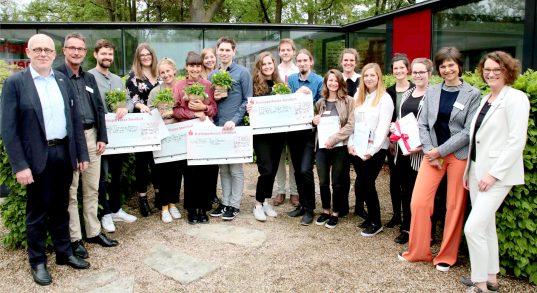
Success for KIT master students: at the second Urban Mining Student Award cycle, students of the Master course “Glück auf am Theodorschacht” organized and taught by the Professorship of Sustainable Construction at the Faculty of Architecture were extremely sucessfull. They won the first, two 3rd and two recognition prizes.
The age of using fossil resources is coming to an end. Far away from the Ruhr area the last days are counted for the German hard coal mining. The Ibbenbüren colliery in the northernmost tip of North Rhine-Westphalia was one of the last two of its kind and was closed at the end of 2018. The surface facilities of the mine are located at various shaft locations and were asked to be re-designed and reused as a public cultural facility, understanding the existing structures and materials as a new ressource for architectural planning.
The award was organized by the agn Niederberghaus & Partner GmbH together with the University of Wuppertal (BUW) and the Association Urban Mining. It recognizes concepts, ideas and strategies for promoting a consistent circular economy. The reusability of the construction and the recyclability of the building materials, together with the reuse of used components and a high level of repair friendliness, are in the foreground of the considerations. Further criteria were the flexibility of the building structures as a prerequisite for reuse and reuse, low space and water consumption, the highest possible building self-sufficiency with low-tec solutions for operational and energy efficiency as well as the promotion of micro-climate and biodiversity.
Winning projects of KIT:
First prize winners: Sofie Fettig and Torben Ewaldt
3rd prize winners: Marieteres Medynska and Jasmin Amann / Ruth Meigen and Lisa-Maria Behringer
Recognition prize winners: Katharina Blümke and Paulina Hipp / Wenzel Meyer and Corinna Kernl
Sudio organization and teaching: Felix Heisel and Karsten Schlesier
Studio consolidation: Prof. Andreas Wagner
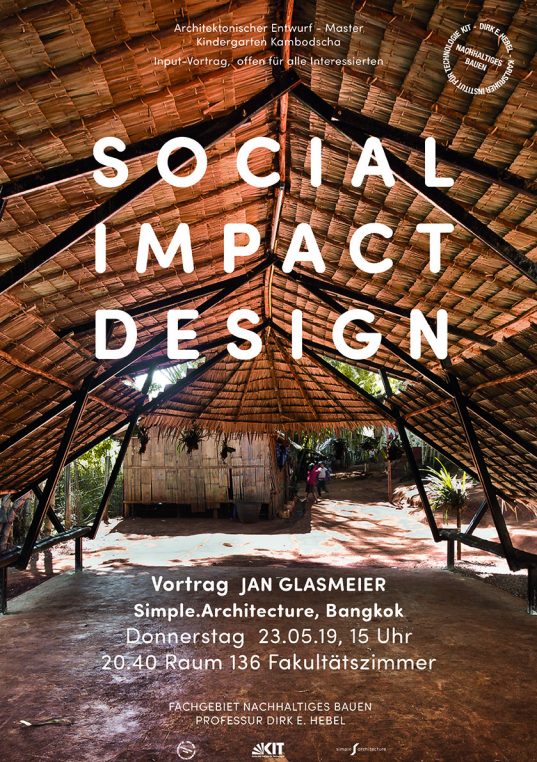
Vortrag JAN GLASMEIER – Simple.Architecture, Bangkok
Donnerstag 23.05.19, 15 Uhr, 20.40 Raum 136 Fakultätszimmer
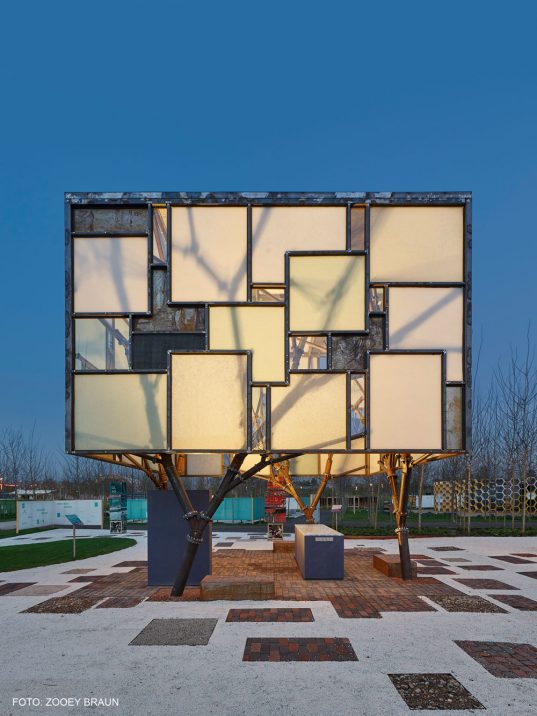
In a grand opening ceremony today, the Federal Garden Show BUGA 2019 in Heilbronn opened its doors to the public in the presence of German president Frank-Walter Steinmeier and state premier Winfried Kretschmann. Located at the center, the Mehr.WERT.Pavillon now houses and represents for the next 6 months an exhibition on resource use and re-use, focusing on Baden-Württemberg and the built environment. The pavilion was designed by KIT students and staff of the professorships Sustainable Construction, Structural Design and Building Technologies, and realised in cooperation with the office 2hs Architekten und Ingenieur PartGmbB.
For more information on the pavilion, please click here.
For information on the program and exhibition, please click here.
For the press kit, please click here.
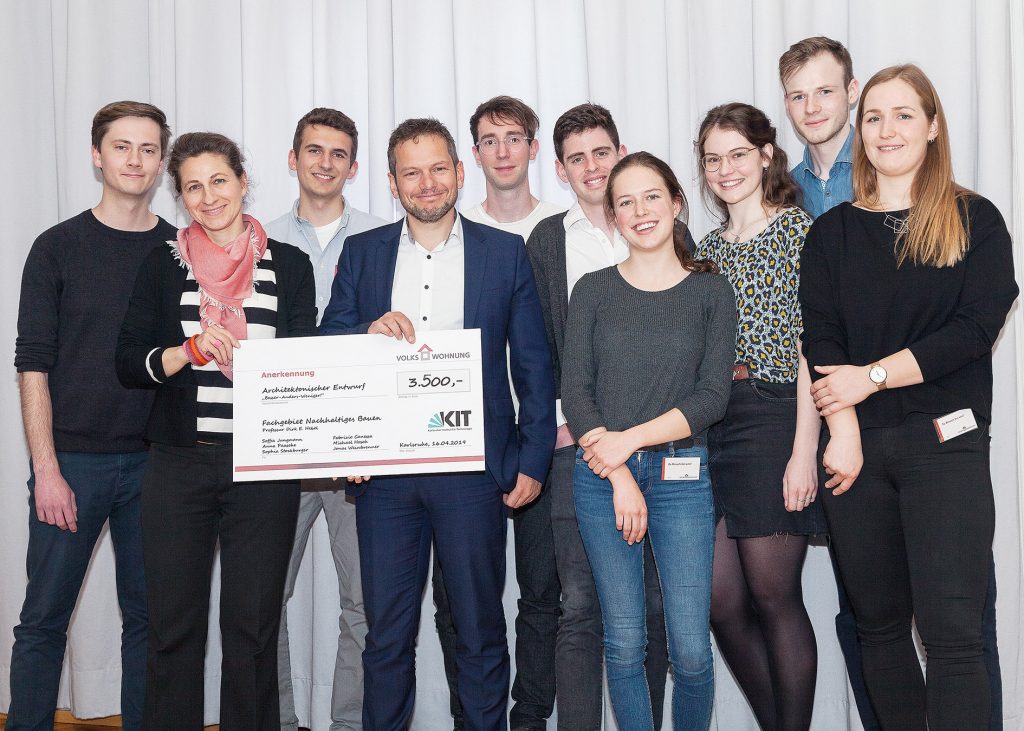
In the fall semester of 2018/19, the Volkswohnung Karlsruhe and the Professorship of Sustainable Construction KIT Karslruhe teamed up and offered a special Bachelor Design Studio called Besser. Anders.Weniger! in order to address the existing lack of affordable urban living space in Karlsruhe. Designs for a socially acceptable redensification is one of the big challenges of these days. Architecture students in their 5th semester at KIT therefore devoted themselves to the question of how good and forward-oriented living can be achieved in the future. The question was how living can be thought BETTER, so that OTHER typological models lead to a rethinking of architectural approaches in urban space, while consuming LESS land, as all designs were asked to be top-up additions to an existing structure in central Karlsruhe. The studio was taught in cooperation with the professorships of Prof. Andreas Wagner and Prof. Matthias Pfeifer as well as Kai Fischer.
A selection of eight of these residential visions was presented at an event on April 16th 2019 at the headquarter of Volkswohnung, attended by Katharina Helleckes, Managing Director Stefan Storz and Mario Rösner.
The student designs and efforts made during the semester were rewarded by Volkswohnung Karlsruhe with a prize money of 3.500 Euro for the students.
Studio organization and teaching: Daniel Lenz and Manuel Rausch
Studio consolidation: Prof. Andreas Wagner, Prof. Matthias Pfeifer, Kai Fischer, Simon Schreiber
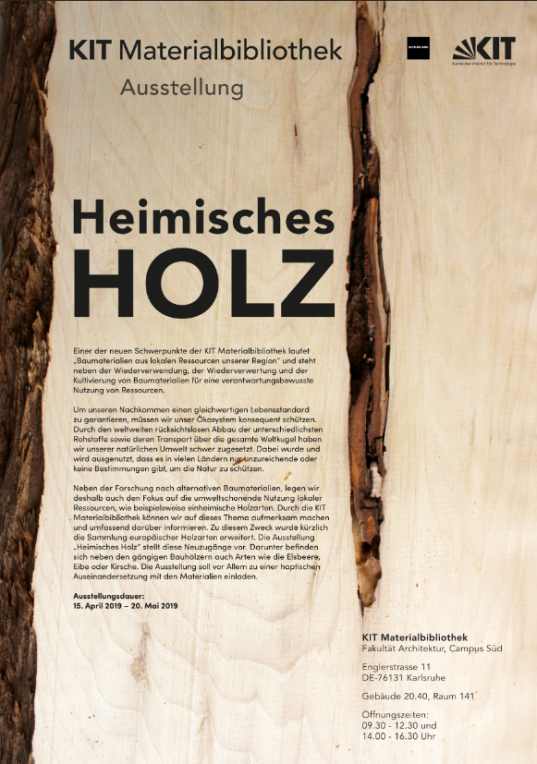
One of the new focal points of the KIT Material Library is “Building Materials from Local Resources of our Region”. This topic stands in addition to the reuse, recycling and cultivation of building materials, for a responsible use of resources.
Through the worldwide ruthless extraction of the most diverse raw materials and their transport across the globe, we have severely damaged our natural environment. It has been and continues to be exploited that in many countries there are insufficient or no regulations to protect nature.
In addition to research into alternative building materials, we therefore also focus on the environmentally friendly use of local resources, such as indigenous wood species. Through the KIT Materials Library, we can draw attention to this topic and provide comprehensive information. The collection of european wood species has recently been expanded. The exhibition “Local Wood” (“Heimisches Holz”) presents these new additions. Above all, the exhibition is intended to invite visitors to a haptic examination of the materials.
Duration of the exhibition:
15 April 2019 – 20 May 2019
Concept and organization: Sandra Böhm
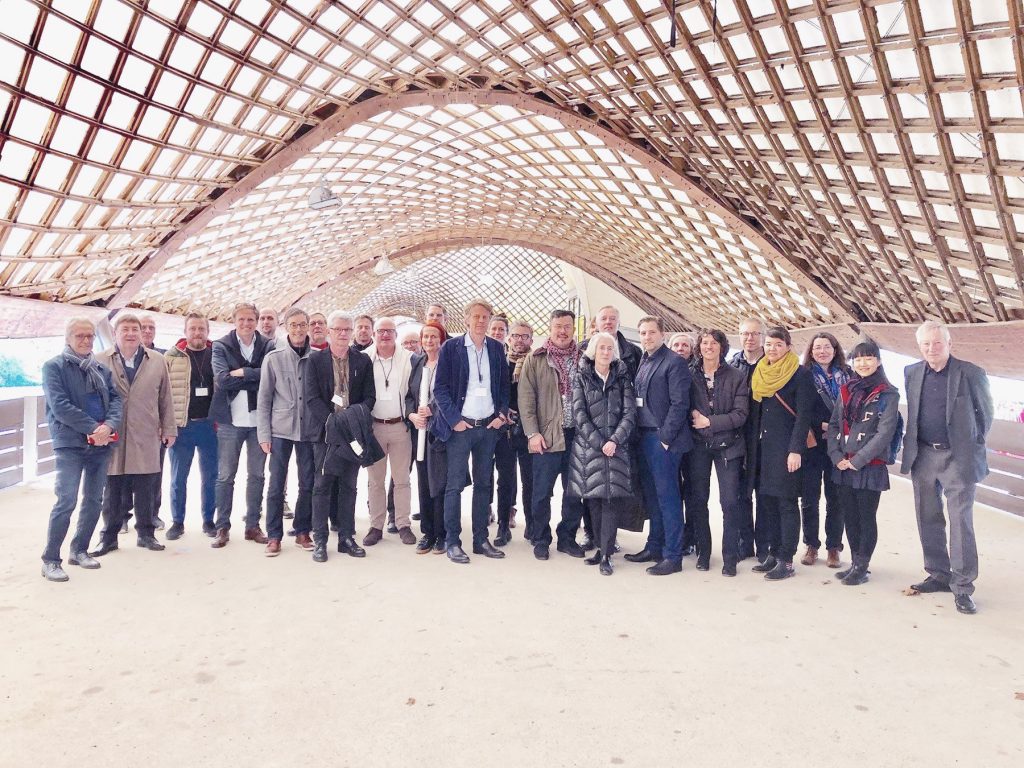
What ideas and visions do the international generation of architects have for the use of the Multihalle as an open space for an open society in the sense of Frei Otto’s thinking? In 2018, the association Multihalle Mannheim e.V., the Association of German Architects BDA Baden-Württemberg and the IBA Heidelberg launched the international ideas competition “MULTIHALLE – DEMOCRATIC UMBRELLA” with this question. Chaired by Peter Schmal, Director of the Architekturmuseum Frankfurt and Prof. Georg Vrachliotis, architecture theorist at the Südwestdeutsche Archiv für Architektur und Ingenierbau in Karlsruhe, the jury not only agreed on the basic guidelines for the future development of the Multihalle, but also awarded three first place winners after a two-day meeting.
See here the link to the promoter’s website.
Construction of the ‘Mehr.WERT.Pavillon’ has started in Heilbronn. The project is a collaboration of several students and experts of the Karlsruhe Institute of Technology KIT and started out as a student design studio called Building from Waste. Stay tuned for exciting updates and save-the-date: Opening of the Federal Garden Show 2019 is on April 17th. More information here.
Karsten Schlesier was appointed as Professor for Structural Design at Hafen City University HCU in Hamburg, Germany. Before accepting his new position, he worked as a researcher at the Professorship of Sustainable Construction at KIT Karlsruhe and was a Visiting Professor for Structural Design at the GUtech Oman from 2014 till 2017. Between 2008 and 2011 Karsten Schlesier joined Addis Ababa University as a Visiting Professor, holding the Chair of Structural Design together with his Ethiopian counterpart Wondimu Kassa at the Ethiopian Institute of Architecture, Building Construction and City Development. He graduated in Civil Engineering from Karlsruhe Institute of Technology (previously TH Karlsruhe) in 1999. Working for different renowned engineering offices, he specialized in the fields of lightweight, membrane and glass structures.
His research activities are focusing on non-standardized and alternative construction materials. During his academic career, he realized various prototypical structures from waste products and cultivated building materials, lately MycoTree, an experimental structure from mycelium for the Seoul Architecture Biennale 2017 and the “Mehr.Wert Pavillon” for the Federal German Garden Exhibition 2019 in Heilbronn. He is partner of 2hs Architects and Engineer together with Felix Heisel and Dirk Hebel.
One year after the operational start, Smiling Gecko celebrated the official opening of the Smiling Gecko School together with guests from sponsors, business and administration, and of course the students and their parents. The Village School started operation in November 2017. In the first year, 136 children attended the school. Since November 2018, 252 pupils and students, aged 3 to 9, already benefit from the ideal learning environment and from a modern bilingual school system. Of these children, 124 attend nursery school (nursery, preschool, kindergarten) and 128 first and second grade in primary school. The SGC HISF Education Campus has been realized and is operated with the generous support of Hartmut & Ilse Schneider Foundation and Prof. Dr. med. Franz Waldeck-Stiftung.
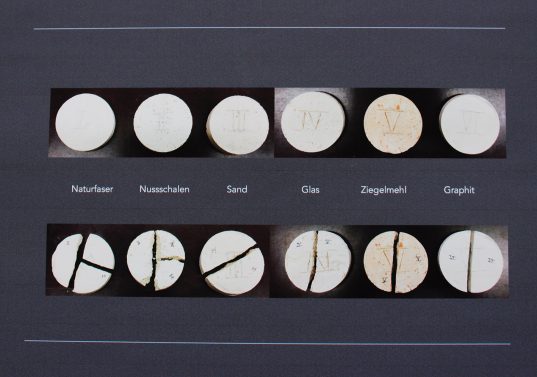
For a long time, ceramics were mostly used for pragmatic construction solutions. Today, a number of innovative technologies have given it a new significance within architecture. These innovations can be found in the material development, in manufacturing processes or in individual application scenarios. Generative technologies offer high potential in terms of resource-efficient production. This is because the layer-by-layer additive manufacturing process only makes material necessary where it is required due to aesthetic criteria and mechanical stress.
In the research seminar “Build up!” students dealt with the development of innovative building materials using ceramic 3D printing. The seminar was held by the Professorship Sustainable Construction in cooperation with the Majolika Ceramics Manufactory in Karlsruhe. The exhibition in the Material Library uses posters, material experiments and printed objects to illustrate the course of the project and further ideas of the group work.
Exhibition duration and location:
20 February to early April 2019
Material Library (Bld. 20.40, R 141)

Approximately one third of the Cambodian population is affected by extreme poverty; 90 percent of them live in rural areas. That is where we will be working. 60 kilometers north of Phnom Penh lies the village of Mea Nork, 10 kilometers west of Odongk Airport in Cambodia.
The NGO “Smiling Gecko” has been operating there for several years. Its aim is to support people – most of them migrating from the slums of Phnom Penh – who want to come back to a self-determined life and a free and independent future. To this end, a community based on an agricultural economical system was started in 2014. The people help each other and use the collective as a reservoir for communication and exchange.
Since 2014, our professorship has supported “Smiling Gecko” in the construction of a school for 1,200 students for this community. The aim is to give the children growing up there the chance of an adequate and well-founded school education. Now “Smiling Gecko” has once again asked our professorship for help. The aim is to design, plan and build a kindergarten in the area.
In order to get to know the socio-cultural, ecological, economic and especially climatic conditions better, we undertake an excursion to Cambodia and to the building site near Phnom Penh at the beginning of the semester. The semester is conducted in cooperation with the professorships of structural design and building physics.
Future economic and ecological development is strongly connected to the question where our resources for future prosperity come from. As our mines run dry and CO2levels are reaching alarming levels, we need to think radically different in all economic sectors. The building industry alone is responsible for 40% of our solid waste production, for 40% of the use of primary energy resources and for 40% of CO2emissions world-wide. We need to change.
Our natural resources are extracted from the earth and then – in a linear process – disposed of. They are literally consumed rather than being temporarily borrowed from natural or socio-technical circuits. This approach has profound consequences for our planet. Ecosystems are destroyed, the climate is jeopardized, and many resources – such as sand, gravel, copper and zinc will soon no longer be available in economically reasonable terms. Humankind is putting at risk the wellbeing of future generations. If we want our environment to be truly sustainable, we need to stop exploiting and polluting our planet as well as destroying our ecosystem by treating it as a waste disposal site. On the contrary, the built environment could be considered as a depository and future provider of resources, a new mine: the Urban Mine.
Considering the human-made environment as a temporary state within an endless circuit of resources constitutes a radical paradigm shift for the building sector. We urgently need new principles for the construction, disassembly, and constant transformation of the built environment. At the same time, the question must be answered of how to produce new materials without further destruction of our ecosystems. Humankind must manage the shift towards activating the already existing materials in our Urban Mine and bind these mineral and metallic resources through cultivating, breeding, raising, farming, or growing of new substances replacing binders which are non-recycable as well as based on extracted and finite raw materials (such as cement).
The potential of the existing Urban Mine as a material depot is gigantic. The challenge is to find new technologies to turn those materials in a new generation of sustainable, non-harmful, non-toxic and endlessly recyclable and de-constructable building materials. We also need to find new ways od creating material passports and connect them to a digital cadastral system, so future generations know where which materials will be available in which quantity and where.
The Professorship of Sustainable Construction at KIT is conducting research in the field of circular construction and was able to build several demonstrator buildings applying new findings, methods and principles of construction in order to achieve this goal.
Recent Publications:
One working day, two cranes and a well attuned team: on 21 November 2017, the woodworkers from the Austrian company Kaufmann Zimmerei und Tischlerei placed the seven prefabricated modules of the Urban Mining and Recycling unit with utmost precision between the projecting platforms of NEST, the research and innovation building of Empa and Eawag in Dübendorf. The interior finishing was implemented in the following few days; and the apartment thus ready to accommodate its first two tenants. Read more here.
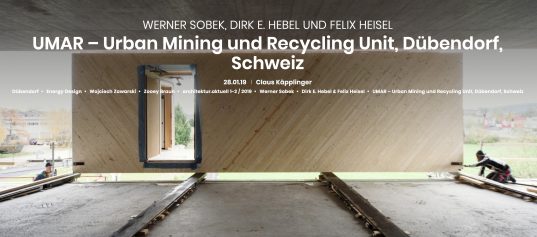
Experimental, educational and even radical is the housing unit UMAR by Werner Sobek, Dirk E. Hebel and Felix Heisel, who not only want to test new materials as real as possible, but also want to permanently change our understanding of buildings and cities. UMAR invites you to discover a building as a material storage and cities as urban mines. Article at architektur.aktuell Austria by Claus Käpplinger.
Read full article here.

Dirk E. Hebel speaks at the BAU Munich 2019 on the conference “Renewable, Rediscovered and Recycled – Materials for Sustainable Construction”. The public debate on the energy balance of construction increasingly focuses on the gray energy of buildings. This refers to the total balance of energy consumed in the manufacture, transportation, processing, use and disposal of building materials. Wood and other renewable building materials and resources are experiencing a comeback, especially in environmentally conscious sectors. The conference “Renewable, Rediscovered and Recycled – Materials for Sustainable Construction” addresses materials in and on buildings that are reusable, biodegradable or renewable, thus ensuring a better climate balance in the construction sector as low-CO2 building materials.
See the full program here.
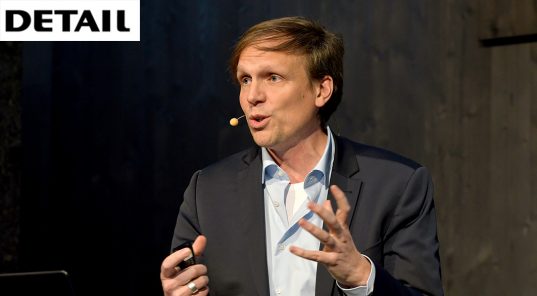
Dirk E. Hebel speaks at the BAU Messe Munich on the question how serial and modular building systems can be a fundamental part of the circular construction economy.
See the full program here.
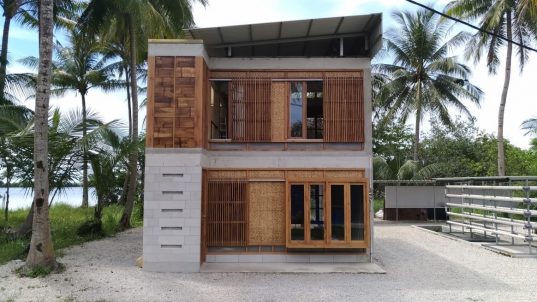

By 2025, Indonesia will need 30 million houses to house its residents, which means the country needs to build around 1.2 million new houses per year. Access to formal public housing, however, especially for the low-income group, is still elusive due to the cost and the difficulties of securing financing.The Tropical Town project by Singapore Future Cities Laboratory’s Urban-Rural Systems team around Prof. Stephen Cairns aims to develop alternative sustainable settlements that provide affordable housing for the low income inhabitants in developing countries, particularly in the tropics.
The planning strategy of Tropical Town is to integrate small living units with public spaces and productive landscapes. Each unit called Rubah can gather 100% of the rainwater for clean water, manage 100% of liquid and solid waste, afford 60% of the self-sufficient energy which will be integrated with an on-grid system with PLN, and 20% of food that family needs. The Rubah has been constructed with help of the Alternative Construction Materials Module FCL Nazanin Saeidi and Alireza Javadian and the Professorship of Dirk E. Hebel at KIT Karlsruhe using local building materials such as bamboo, Meranti timber, rammed earth, and mycelium. The kitchen has been designed as a mobile kitchen to provide the opportunity to run a small food business to increase household incomes.
The first phase of Tropical Town was an explorative study conducted through symposiums, workshops and exhibitions in Singapore, the Netherlands, Switzerland, Germany and Indonesia. The second phase of this project is focused on design development, experimental studies and the implementation of the ground floor construction of the Rubah unit along with the provision of the smallest systems in Tropical Town. The third phase will continue with design development, the experimental and construction studies of the Rubah’s upper floors.
The Alternative Construction Materials Module FCL and the Professorship of Dirk E. Hebel at KIT Karlsruhe has also taken responsibility for design and construction of the second and third phase of the project. Currently the team has finished the production of newly developed bamboo composite elements as an external wall cladding element. The team together with Mycotech from Indonesia has also finished the production and installation of innovative mycelium tiles as an internal wall cladding and is currently finalizing the design for the 3rd floor of the building, which should be finished also this year.

We are happy to announce the publication of the new DGNB (German Association of Sustainable Construction) report on Circular Economy with several contributions from the Professorship of Sustainable Construction at KIT Karlsruhe, including next to several projects carried out by the team over the past months (UMAR Experimental Unit in Dübendorf, Switzerland and the MycoTree project for the Seoul Biennale, South-Korea) also a pedagocical concept of a new Material Library at the Faculty of Architecture at KIT Karlsruhe.
The concept of a Circular Economy is intended to ensure the availability and quality of resources for future generations through appreciation, reuse and recycling. With the new report, the DGNB want to demonstrate the potential of a circular economy in the construction industry and promote its implementation and integration into construction practice. The publication is dedicated to the responsible use of resources and the manifold requirements of a circular economy in the context of building planning, implementation and use.
Download-Link: „Circular Economy – Kreisläufe schließen, heißt zukunftsfähig sein“
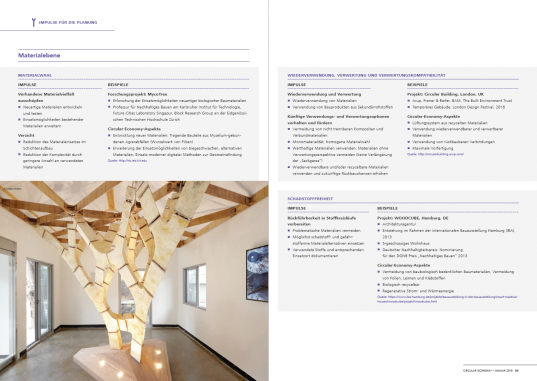
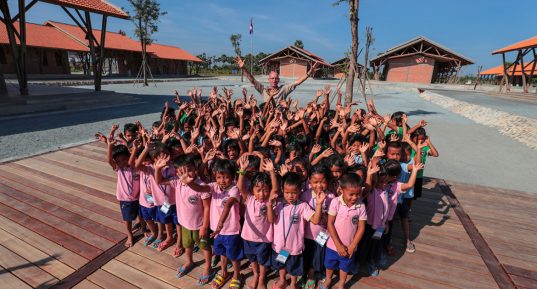
One year after the completion of the structures and the operational start, Smiling Gecko celebrated the official opening of the Smiling Gecko School together with guests from sponsors, business and administration, and of course the students and their parents in early December 2018. The celebrations stretched over two days. The first day started with a lunch in the kitchen of the new food processing center, open since November 2018, where students and the invited guests got to know each other better. The aim of the second day was to give the guests an insight into the school life of the children.
The architectural project involves the construction of a new school, consisting of 24 classrooms, 15 group study rooms, 3 workshop rooms, an administrative wing, a library, cafeteria, community laundry, community medical clinic, toilets, staff dormitories, an outdoor assembly space, playgrounds and a lake.
The architectural project was designed by Lisa Devenoge, Oliver Faber, Lorine Grossenbacher, Franziska Matt, Elizabeth Müller, and Alina Wyder with Prof. Dirk E. Hebel under the request of the NGO Smiling Gecko.
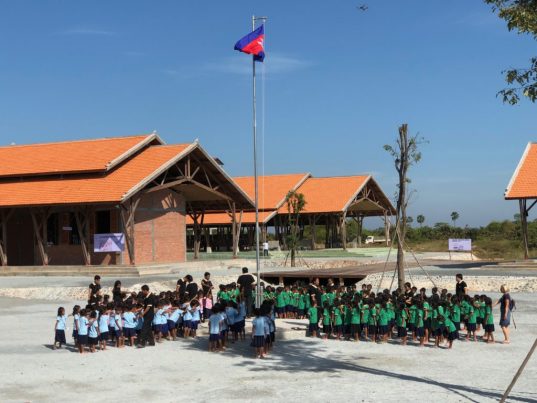
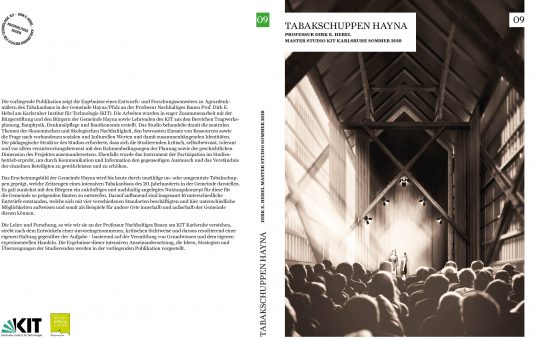
The publication presents the results of a design and research semester on agricultural monuments of tobacco cultivation in the municipality of Hayna / Pfalz at the Professorship of Sustainable Construction Dirk E. Hebel at the Karlsruhe Institute of Technology (KIT). The work was carried out in close collaboration with the citizens of the municipality Hayna and scientists of the KIT from the areas of structural engineering, building physics, historic preservation and building economics. The studio dealt with the central themes of economic and environmental sustainability, the conscious use of resources and the question of existing social and cultural values and related identities.
Editorial Staff: Sonja Steenhoff, Daniel Lenz, Manuel Rausch. Graphic Concept and Design: Uta Bogenrieder and Sonja Steenhoff, KIT Karlsuhe, Professorship of Sustainable Construction Dirk E. Hebel, December 2018, 195p.
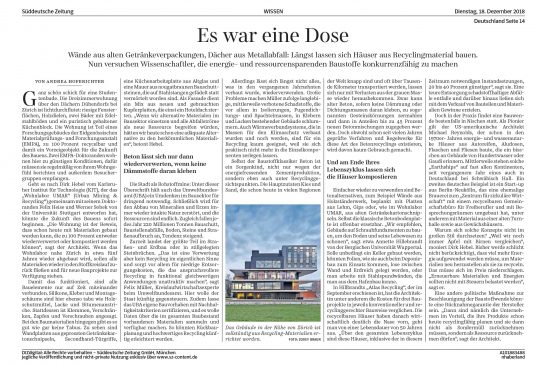
Walls made of old beverage packaging, roofs made of metal waste: houses can be built from recycled materials. Now scientists are trying to make the energy and resource-saving building materials competitive. Article in the Süddeutsche Zeitung. December 18, 2018, by Andrea Hoferichter, Süddeutsche Zeitung, Deutschland S.14.
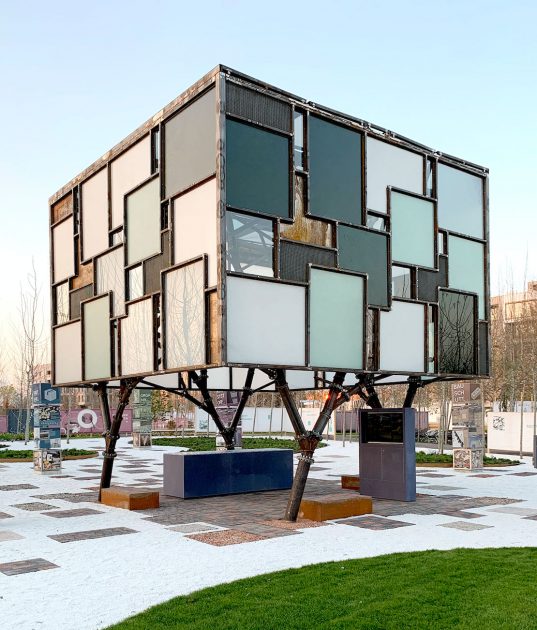
The 2019 German Federal Garden Show (BUGA) in Heilbronn is both garden and city exhibition. The newly built city quarter Neckarbodenis intends to be a test bed for a new urban area that exemplifies how people live well together in a densely populated urban setting. In this context, the relevance of the question of resources that will still be available and sustainably used in the future cannot be overestimated.
Situated on a central lot of the BUGA terrain, the Mehr.WERT.Garten (translation: Added.VALUE.Garden) and its pavilion address the question how we can perform a paradigm shift in the way we use our resources, from the currently dominant linear economy (take, make, throw) towards a circular economy of closed and pure material cycles. The Mehr.WERT.Pavilion is the shell, as well as main element of an exhibition on local and global resource use, alternative materials as well as their applications in a circular design and construction. On the one hand, the pavilion makes use of the existing urban mine – all materials used in the project have already undergone at least one life cycle, either in the same or in a different form. On the other hand, it acts as a material depot, which will become available again for future constructions at the end of the exhibition. As such, materials utilised in the construction of the Mehr.WERT.Pavillon are specified and employed in a way that allows their complete re-introduction into pure and type-sorted material cycles for reuse, recycling or bio-degradation after the decommissioning and deconstruction of the building. The pavilion’s objective is to proof that it is possible already today to design, detail and construct according to the principles of the circular economy.
The pavilions building materials are separated into four groups: (1) the load-bearing structure is largely made from reused steel originating from a disused coal-fired power plant in north-western Germany. It consists of four inclined supports that fan out like trees and are connected to each other by a rigid steel frame structure. (2) The façades and roof are clad in panels manufactured from recycled bottles glass and industrial glass waste. (3) The furniture is built from recycled HDPE plastic waste, while the chairs are 3D printed from plastic household waste. (4) The floor of the pavilion as well as the landscape design of the garden forms an assemblage of various reused and recycled materials and products made from mineral construction and demolition waste.
Mehr.WERT.Pavillon serves as a laboratory and test run for future construction projects as well as their building processes. The aim is to discuss important issues of construction and the associated use of resources with decision-makers from politics, construction planning and implementation and to develop new innovative concepts, applications and methods, both in practice and in teaching. The pavilion design originated in the design studio Building from Waste of the Professorship of Sustainable Construction at KIT Karlsruhe. It was further developed by KIT students Lisa Krämer, Simon Sommer, Philipp Staab, Sophie Welter, and Katna Wiese in collaboration with the Professorships Tragkonstruktionen (Prof. Matthias Pfeifer / Certification engineer) and Bautechnologie (Prof. Rosemarie Wagner / Structural form finding), as well as the office 2hs Architekten und Ingenieur PartGmbB.
Project credits
Client:
Entsorgungsbetriebe der Stadt Heilbronn
Ministerium für Umwelt, Klima und Energiewirtschaft Baden-Württemberg
Bundesgartenschau Heilbronn 2019 GmbH
Pavillon:
Design: Lisa Krämer, Simon Sommer, Philipp Staab, Sophie Welter, Katna Wiese, Professorship of Sustainable Construction, KIT Karlsruhe
Planning, structural design and execution: 2hs Architekten und Ingenieur PartGmbB Hebel Heisel Schlesier with Lisa Krämer and Simon Sommer
Structural form finding: Prof. Rosemarie Wagner, Fachgebiet Bautechnologie, KIT Karlsruhe
Certification engineer: Prof. Matthias Pfeifer, Karlsruhe, Germany
Object construction: AMF Theaterbauten GmbH
Electrical and lighting design: Udo Rehm / FC-Planung GmbH
Lightning protection: Gebr. A. & F. Hinderthür GmbH
Electrical installation: Elektro-Scheu GmbH
Furniture construction: Kaufmann Zimmerei und Tischlerei GmbH
Visualizations: Manuel Rausch
Video Documentation: Fülmbüro – Videoproduktion Stuttgart
Garden and exhibition:
Landscape architecture: Frank Roser Landschaftsarchitekten PartGmbB
Landscaping: GrünRaum GmbH
Exhibition design: Idee-n, Büro für nachhaltige Kommunikation
Exhibition construction: ING.Büro Wegweiser
Recycling workshop: Kunststoffschmiede / Konglomerat e.V.
E-waste art: Prof. Abraham David Christian, Vito Pace, Fakultät Gestaltung, Hochschule Pforzheim
Project partner:
AMF Theaterbauten GmbH, Deutsche Foamglas GmbH, Glas Trösch GmbH, Hagedorn GmbH, Handy-Aktion Baden-Württemberg, Heinrich Feeß GmbH & Co. KG, Institut für Umwelt- und Zukunftsforschung – Sternwarte Bochum, Magna Naturstein GmbH, Really ApS, Schröder Bauzentrum GmbH / DeFries, Smile Plastics, SPITZER-Rohstoffhandelsgesell. mbH Selb, StoneCycling BV, Studio Dirk Vander Kooij
Main sponsors:
GreenCycle GmbH
DSD – Duales System Holding GmbH & Co. KG
SER Sanierung im Erd- und Rückbau GMBH

We are excited to announce the arrival of our newest book publication. Today, Addis Ababa: A Manifesto on African Progress by Dirk E. Hebel, Felix Heisel, Marta H. Wisniewska and Sophie Nash was published by Ruby Press.
This publication is centred around twelve manifesto points towards a people-centred urbanism and an architecture of belonging in times of rapid global urbanisation. Based on the authors’ eleven year research experience, the book draws conclusions from Addis Ababa, the capital of Ethiopia, as its case study. It contains essays on the historic development and the current housing situation of the city by local experts and numerous project examples. Adressing policy makers, architects and urban planners alike, the manifesto gives a series of clues and guidelines for a sustainable urbanisation of contemporary African metropolis.
244 p, ills colour & bw, 19 x 26 cm, pb, English – Available here.

take. build. repeat. Symposium für ressourcengerechtes Bauen.
09.11.2018 / 9:30 – 18:00 Uhr
Fachgebiet Nachhaltiges Bauen
KIT Karlsruher Institut für Technologie
Egon-Eiermann-Saal, Englerstr. 7, Geb. 20.40
The symposium take.build.repeat. questions the currently practiced throw-away mentality of today’s construction industry: Resources are taken, consumed and subsequently disposed of. Contrary to this linear concept of ressource destruction are ideas of closed material cycles, of newly conceived (re-)building technologies and, in particular, new business models of the circular economy. The symposium addresses the important question of how we can build our cities of the future in times of ever-growing global population and increasing resource scarcity without continuing to exploit and pollute our natural environment. The built environment must represent both a responsible present-day solution as well as the material bank for the future.
The one-day symposium will bring together representatives of science and industry, theoretical and practical approaches as well as practitioners and students to jointly shape the future of building through lectures and discussions. Speaking will be Prof. Dr. Werner Sobek (Werner Sobek Group / University Stuttgart), Prof. Dr. Walter R. Stahel (Product Life Institute), Prof. Annette Hillebrandt (University of Wuppertal), Peter van Assche (Bureau SLA), Jasper Brommet (StoneCycling), Stefan Rohrmus (Schüco) and Sabine Oberhuber-Rau (Madaster). The recently opened Urban Mining and Recycling unit (UMAR) at the Empa NEST in Switzerland by Werner Sobek with Dirk E. Hebel and Felix Heisel will be presented in detail.
The event on 09. November 2018 is organized by Sustainable Construction at the Faculty of Architecture of the Karlsruhe Institute of Technology KIT and is recognized as Weiterbildungsmaßnahme by the Chamber of Architects Baden-Württemberg with 4 hours.
Registrations at http://www.arch.kit.edu/aktuelles/take_build_repeat.php
More information at www.nest-umar.net


Dirk. E. Hebel, our Urban Miner of the month October, is professor for Sustainable Construction. Currently he teaches at the Karlsruher Institut für Technologie. One of his latest projects using exclusively recycled building materials was UMAR. In his answers he puts the focus on his work and points out, that the Netherlands are the leading nation in the field of reuse and recycling in the building sector.
Read full texte here

19 .11. 2 018
Eva Pfannes & Sylvain Hartenberg, Rotterdam in conversation with DIRK HEBEL
SESSION ON TERRITORY is a series of public debates on the political economy of architecture and territory. Focusing on how the epoch of the Anthropocene reframesbour conceptions of the urban and shapes new ecologies,mthe seminar’s objective is to unravel contemporary forces at work in the formation of the built and natural environment, and, as importantly, to spur debates that challenge the status quo. Every intervention by a guest speaker is followed by a panel discussion with invited respondents.
In the winter semester 2018/19, Sustainable Construction offers a bachelor and a master design studio, a seminar as well as a Stegreif. For more details please refer to the respective posters or detailed information in the navigation on the left.
We wish all students a successful beginning of the new semester!
In the Winter Semester 2018/19, the KIT Faculty of Architecture will offer a lecture series on Sustainable Construction, organized by the chair of Sustainable Construction, Dirk E. Hebel. In total 14 lectures will address the history, state of the art, and alternative futures within the theme. Speakers are: Michael Dax, Felix Heisel, Dörte Meinerling, Daniel Fuhrhop, Roland Hischier, Prof. Andreas Wagner, Prof. Matthias Pfeifer, Prof. Petra v. Both, Prof. Markus Neppl, Jan Wurm, and Prof. Dirk E. Hebel. Please refer to the poster for actual dates. The lecture is held every Wednesday, 09:45 am in Lecture Hall 9 (HS09) at KIT Campus South, Building 20.40.
Poster Design: Uta Bogenrieder
In the Winter Semester 2018/19, the KIT Faculty of Architecture will offer a lecture series on Materials, organized by the chair of Sustainable Construction, Dirk E. Hebel. In total 13 lectures will address conventional and alternative building materials and their use in construction. Speakers are: Sandra Böhm, Waltraud Vogler, Peter Schöffel, and Prof. Dirk E. Hebel. Please refer to the poster for actual dates. The lecture is held every Friday, 09:45am in Lecture Hall Egon-Eiermann at KIT Campus South, Building 20.40.
Poster Design: Uta Bogenrieder

In his capacity as 2018 Harvard GSD Guest Lecturer, Felix Heisel is presenting a lecture titled ‘Resource-Adequate Construction’ on 26th September 2018 at Gund Hall, Cambridge, USA within the reCyclo Design Studio by Visiting Associate Professor in Architecture Caroline O’Donnell. For more information please click here.

On October 16th 2018, Prof. Dirk E. Hebel is speaking at the Detail Kongress 2018 »No Waste! Ressource Bau« about the NEST Unit Urban Mining and Recycling by Werner Sobek with Dirk E. Hebel and Felix Heisel. Located at the Oktagon of Zeche Zollverein in Essen, the congress brings together partitioners, researchers and positions aiming to promote a more respectful resource and energy use in the built environment.
Registration at detail.de/detailkongress
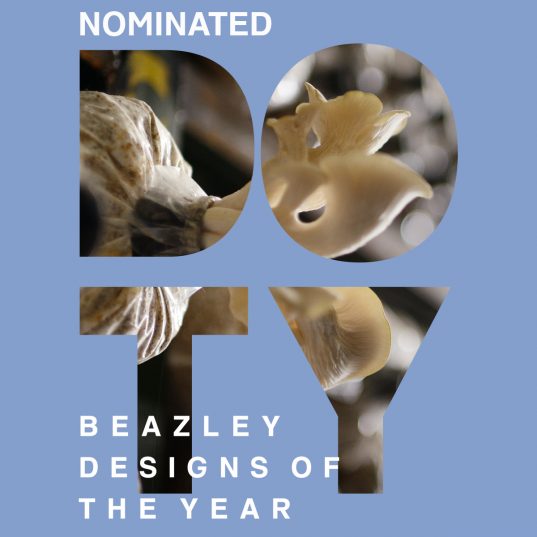
Our 2017 MycoTree for the Seoul Biennale of Architecture and Urbanism is nominated for the Beazley Design of the Year 2018 Award. #BeazleyDesignsoftheYear
MycoTree is a spatial branching structure made out of load-bearing mycelium components. Its geometry was designed using 3D graphic statics, keeping the weak material in compression only. Its complex nodes were grown in digitally fabricated moulds.
Utilising only mycelium and bamboo, the structure represents a provocative vision of how we may move beyond the mining of our construction materials from the earth’s crust to their cultivation and urban growth; how achieving stability through geometry rather than through material strength opens up the possibility of using weaker materials structurally and safely; and, ultimately, how regenerative resources in combination with informed structural design have the potential to propose an alternative to established, structural materials for a more sustainable building industry.
MycoTree is the result of a collaboration between Sustainable Construction at Karlsruhe Institute of Technology (KIT), the Block Research Group at the Swiss Federal Institute of Technology (ETH) Zürich and the Alternative Construction Materials Unit of the Future Cities Laboratory Singapore. It was the centrepiece of the “Beyond Mining – Urban Growth” exhibition at the Seoul Biennale of Architecture and Urbanism 2017 in Seoul, Korea curated by Hyungmin Pai and Alejandro Zaera-Polo, and was on display in Pavilion i7 at the Donuimun Museum Village from September 1st 2017 to March 31st 2018.
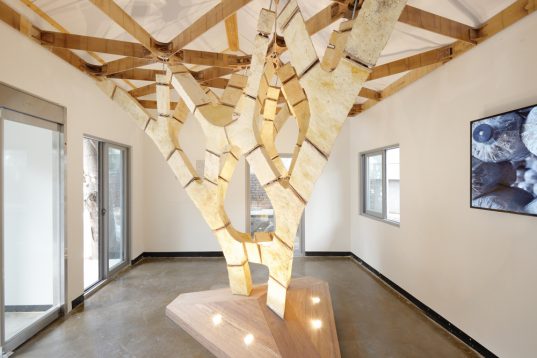
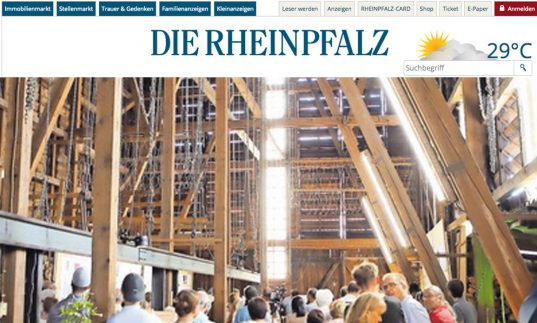
You can not create living space or a new business models in and with old tobacco sheds? But on the contrary. Students of the University of Karlsruhe present innovative usage concepts for some of the historic buildings. The only question is whether visions can ever become reality.
Read full article here (German)
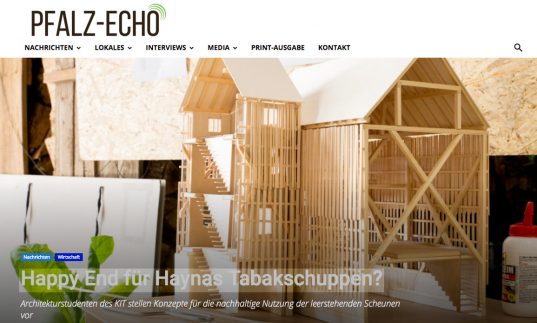
What do you do with a building that towers high into the sky, that radiates with its charm and not only makes some inhabitants of the village Hayna nostalgic? 16 students from the Faculty of Architecture at the Karlsruhe Institute of Technology (KIT) spent more than four months investigating this question. At the beginning of August, the students introduced themselves and their concepts for using the vacant tobacco sheds in Hayna.
read the full article here (German)
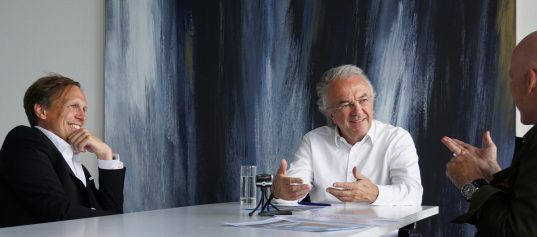
For materials that are no longer needed, there was for the longest time only one word: waste. Following this linear mentality of “take, make and waste” the term “disposable society” came up in the second half of the 20th century. With the start of the oil crisis in the 1970s this ideology started slowly to be rethought. Today, people talk less about waste when dealing with materials they no longer need. One speaks of “ressources”. In form of an interview, Werner Sobek and Dirk E. Hebel take their latetst building project UMAR to discuss future concepts of a circular econmy within the built environment. They formulate where in their view future research, teaching concepts and practical work need to address one of the most important questions of the 21st century: where to source the materials to build for more with less.
Read the full interview here (in German).
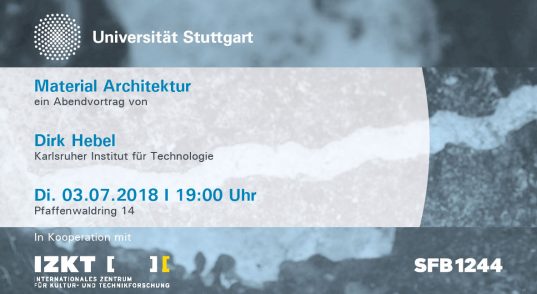
On 3rd Juli, Dirk E. Hebel will be speaking at the SFB1244 lecture series “Adaptivität als Utopie” at Stuttgart University. Titled “Material Architektur”, the lecture will start at 7pm at the ILEK, Pfaffenwaldring 14. For more information, please click here.
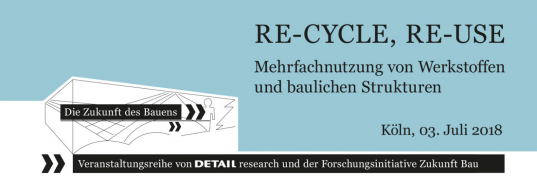
On 03. Juli, Felix Heisel is speaking at the Re-Cycle, Re-Use conference in Cologne about “innovative building concepts for the 21st century”. The full program and a link for registration can be found here.

Dietzold, Lutz, ed. Iconic Awards 2025 – Spaces Objects Visions. Frankfurt: Rat für Formgebung GmbH, 2025.
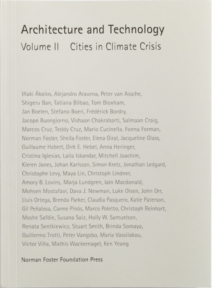
Hebel, Dirk E. “Activating the Urban Mine.“ In Architecture and Technology Volume II: Cities in Climate Crisis. Madrid: Norman Foster Foundation Press, 2025.

Hebel, Dirk E. und Felix Heisel. “Die Stadt als Ressource.” In Für eine nachhaltige Architektur der Stadt. Berlin: Verlag Klaus Wagenbach, 2025.
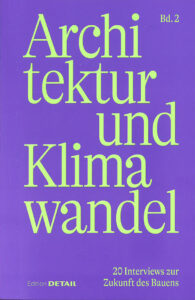
Hebel, Dirk E. “Vom Linearen Zum Kreislaufsystem.” In Architektur Und Klimawandel. München: Edition DETAIL, 2025.
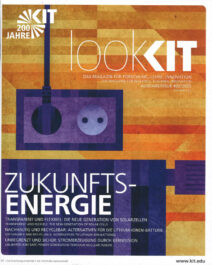
Hebel, Dirk E. Interview: “Wir müssen endlich anfangen, den CO2-Ausstoß zu messen – nicht nur, wie dick die Dämmung ist.” Interview by Christoph Karcher. LooKIT 0225, 2025.
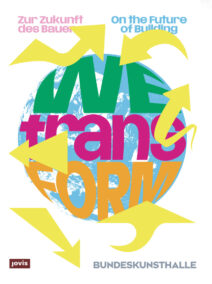
BUNDESKUNSTHALLE, ed. WEtransFORM – Zur Zukunft Des Bauens. Berlin: jovis Verlag, 2025.
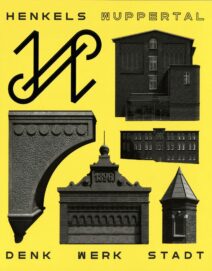
Renaissance AG, ed. Henkels Wuppertal – DenkWerkStadt. Wuppertal: renaissance Immobilien und Beteiligungen Aktiengesellschaft, 2025.
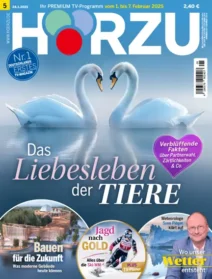
Monkenbusch, Helmut. „Bauen für die Welt von morgen.“ Hörzu, 24.1.2025
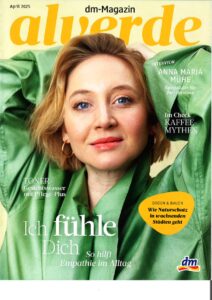
Hebel, Dirk E., Tanja Hildbrandt. „ Pilze – Netzwerker im Untergrund“. alverde, dm-Magazin, April 2025.
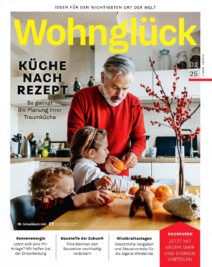
Merkert-Andreas, Carolin. “Pilze Sind Vielseitig.” Wohnglück, January 2025.
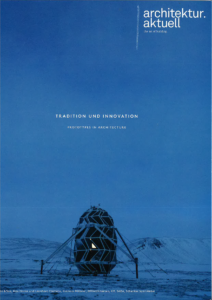
Boerman, Elena, and Dirk E. Hebel. “RoofKIT – Kohlenstoffspeicher Und Materiallager.” Architektur.Aktuell, vol. 12.2024, no. Tradition und Innovation, Dezember 2024, pp. 98–109

Hebel, Dirk E. Interview: “Vom linearen zum zirkulären Kreislaufsystem.” Interview by Sandra Hofmeister, DETAIL 11.2024, Nov. 2024.

Hebel, Dirk E., Sandra Böhm, Elena Boerman, Hrsg. Vom Bauen mit erneuerbaren Materialien – Die Natur als Rohstofflager. Stuttgart: Fraunhofer IRB Verlag, 2024.
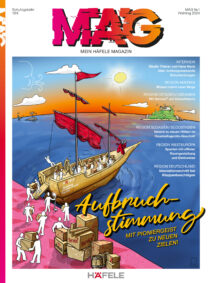
Hebel, Dirk E. “In Kreisläufen denken, entwerfen und wirtschaften.” MÄG – Mein Häfele Magazin, 2024.

Rubel, Maike, and Patricia Leuchtenberger. Interview: “Pilzpower für die Bauindustrie.” competitionline, 7 June 2024, https://www.competitionline.com/de/news/schwerpunkt/pilzpower-fuer-die-bauindustrie-7283.html.
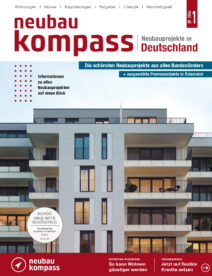
Müller, Janek. “Baumaterialien der Zukunft: Pilze, Hanf und Algen.” neubau kompass – Neubauprojekte in Deutschland, May 3, 2024. https://www.neubaukompass.de/premium-magazin/.
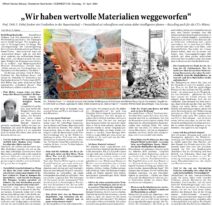
Sören, S. Sgries. “Interview: ‘Wir haben wertvolle Materialien weggeworfen.’” Rhein-Neckar-Zeitung, April 27, 2024, SÜDWEST I 28 edition, sec. Sinsheimer Nachrichten.

Schweikle, Johannes. “Auf Pilz gebaut.” Stuttgarter Zeitung, April 23, 2024, sec. Die Reportage.

Klaaßen, Lars. “Organische Architektur – Pilzmyzel und Flachs als Materialien für die ökologische Bauwende.” In Deutsches Architektur Jahrbuch 2024, edited by Peter Cachola Schmal, Yorck Förster, and Christina Gräwe, 198–209. Berlin, Germany: DOM publishers, 2024.
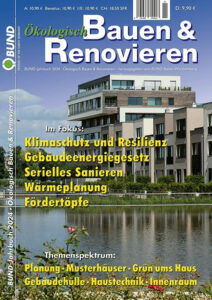
Streiff, Peter. “Zirkuläres Bauen – Kreislauf statt Abriss.” BUND-Jahrbuch – Ökologisch Bauen & Renovieren 2024, January 2024.
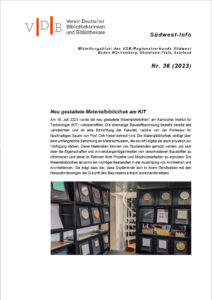
Mönnich, Michael, and Sandra Böhm. “Neu gestaltete Materialbibliothek am KIT.” Südwest-Info: Mitteilungsblatt des VDB-Regionalverbands Südwest Nr. 36 (2023), 2023.

Hebel, Dirk E. “RoofKIT Wuppertal, Germany; Interview with Prof. Dirk Hebel: The aim is clear, we must forge the path ourselves.” In Sustainable Architecture & Design 2023/ 2024, edited by Andrea Herold, Tina Kammerer, and InteriorPark., 46–55. Stuttgart, Germany: av edition GmbH, 2023.
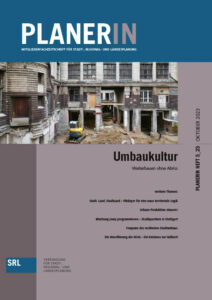
Hebel, Dirk E. “Der Bestand ist die künftige Ressource – Den linearen Umgang mit Baumaterialien schnellstmöglich stoppen.” Planerin – Mitgliederfachzeitschrift für Stadt-, Regional- und Landesplanung, Oktober 2023.
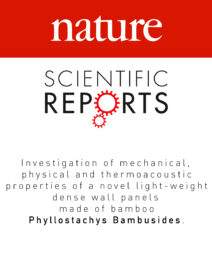
Gholizadeh, Parham, Hamid Zarea Hosseinabadi, Dirk E. Hebel, and Alireza Javadian. “Investigation of Mechanical, Physical and Thermoacoustic Properties of a Novel Light-Weight Dense Wall Panels Made of Bamboo Phyllostachys Bambusides.” Nature Sientific Reports 13 (October 26, 2023). https://doi.org/https://doi.org/10.1038/s41598-023-45515-3

Hebel, Dirk E., Felix Heisel, Andreas Wagner, und Moritz Dörstelmann, Hrsg. Besser Weniger Anders Bauen – Energiewende und digitale Transformation. Besser Weniger Anders Bauen 2. Basel: Birkhäuser Verlag GmbH, 2023.

Hebel, Dirk E. “Vom Jagen, Züchten Und Ernten Zukünftiger Baumaterialien.” Baukultur Nordrhein Westfalen, September 2023.

Hebel, Dirk E., Ludwig Wappner, Katharina Blümke, Valerio Calavetta, Steffen Bytomski, Lisa Häberle, Peter Hoffmann, Paula Holtmann, Hanna Hoss, Daniel Lenz and Falk Schneemann, eds. Sortenrein Bauen – Methode Material Konstruktion. Edition DETAIL. München: DETAIL Business Information GmbH, 2023.

Schweikle, Johannes. “Fungi.” In Earthlike, 1:70–75, 2023.

Hebel, Dirk E. “Die Stadt als Rohstofflager.” wohnen – Zeitschrift der Wohnungswirtschaft Bayern, August 2023.
Hebel, Dirk E. “Das RoofKIT-Gebäude der KIT Fakultät für Architektur – Gewinner des Solar Decathlon 2021/22 in Wuppertal.” wohnen – Zeitschrift der Wohnungswirtschaft Bayern, August 2023.

Hebel, Dirk E. “Die Stadt Als Rohstofflager.” Aktuell – Das Magazin Der Wohnung- Und Immobilienwirtschaft in Baden-Württemberg, 2023.